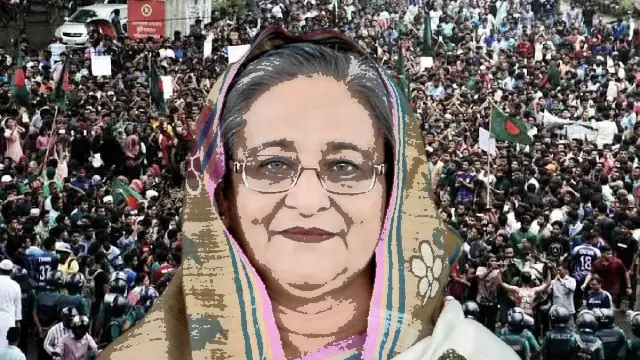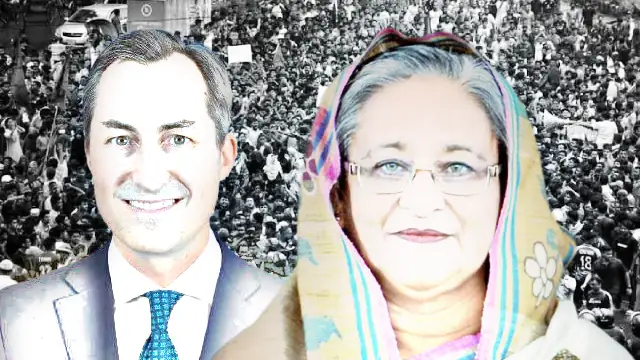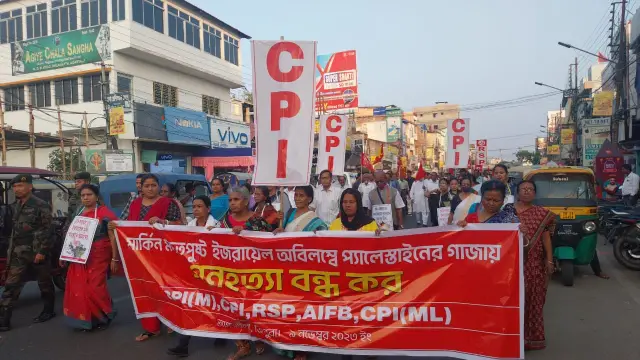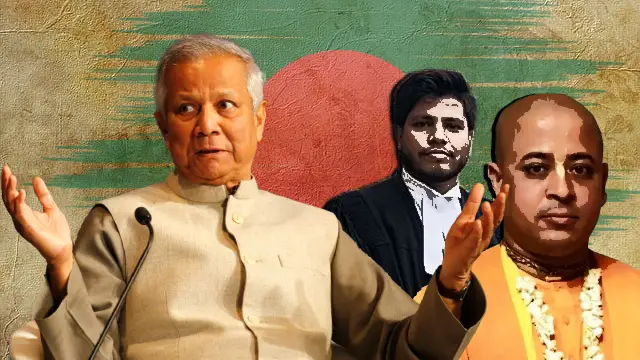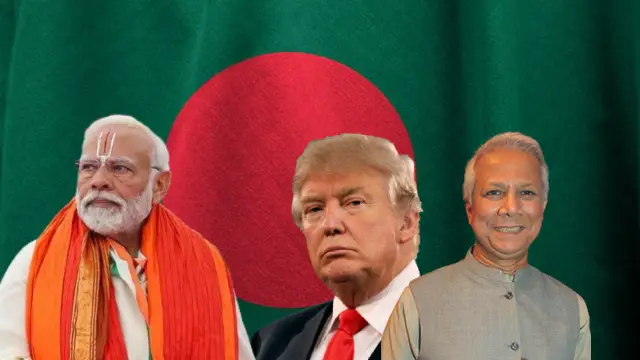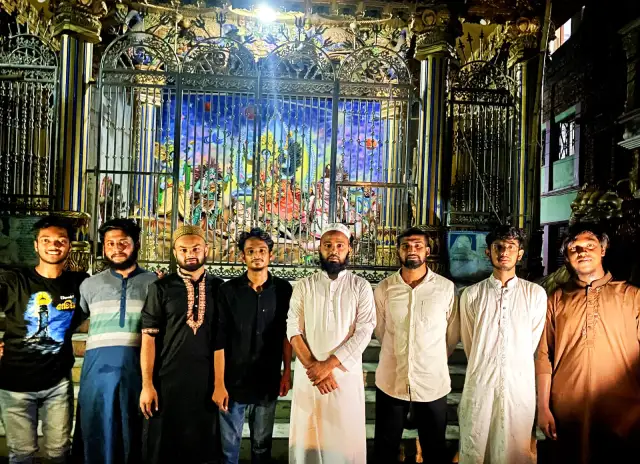July didn’t follow the Gregorian rule in Bangladesh. It didn’t end on the 31st day. The protesting students and youths continued counting the month even after July 31st. On August 5th, former prime minister Sheikh Hasina’s ignominious downfall, following a massive uprising of the students and youths, finally ended July for them. August 5th became July 36th for Bangladesh, as the youngsters refused to go off the month that was crimsoned with the blood of their compatriots, classmates, siblings and neighbours. Ms Hasina’s downfall ushered in a new dawn for the youngsters, although, behind the bright, glaring canvas displaying the celebratory mood of the South Asian nation, dark gloomy clouds loom.
Ms Hasina’s downfall on August 5th not only ended her controversial 16-year-long rule, during which, it’s alleged, a large section of Bangladeshi youths could never experience the right to elect their representatives, media outlets couldn’t hold the government accountable and a large number of critics of the government were either found murdered or went missing forever. It also ended a period in the history of the country where its history, cultural and national identity were rewritten and the systems were allegedly tweaked to support nepotism and corruption.
But does Ms Hasina’s downfall end all troubles for Bangladesh? Or is it pushing it towards another episode of uncertainties and volatility?
To comprehend that, it’s important to understand the context that led to her regime’s monumental collapse.
Reasons behind Hasina’s downfall
While Ms Hasina’s downfall was aggravated by the killings of over 300 students and youths across the country since July 15th, it’s not the sole cause. The killings took place when Ms Hasina’s government refused to engage with the students and resorted to the use of brute force to suppress the discontent against a controversial reservation system in government jobs, which is now scrapped by the Supreme Court. However, behind the protests was the anger that has been accumulated against Ms Hasina and her Awami League’s rule.
Since 2009, Ms Hasina has been disdained by the Bangladeshis due to several reasons.
“I think there is no other fascist regime like her’s in the present-day world,” Shaherin Arafat, a senior associate editor of Samakal in Dhaka told the East Post. Highlighting the reasons behind her downfall he said volumes can be composed if we sit down and discuss her government’s sheer abuse of power, especially since the 2014 elections. Mr Arafat believes that Ms Hasina’s downfall was inevitable due to her complete disregard for democratic values and ethos.
Britain-based Bangladeshi geopolitical analyst Ahmed A Shahbaz also believes that consolidating power and turning the state into an autocratic one was behind Ms Hasina’s downfall.
“The protest was caused by a long and ongoing political crisis in the country, as the government of Sheikh Hasina turned into a one-party, one-woman dictatorial regime. It turned into a personality cult, over her deceased father (Sheikh Mujibur Rahman) and one of the important founders of the country. The 15-year rule of her Awami League has caused many hardships for people from all classes and backgrounds in the country. The corruption in the government, the police, the military, the businesses and even the education system was paramount. The entire nation felt repressed and forced to obey one woman and her cult. Positions in government and these institutions were given based on their relations with the Sheikh family and on donations from the businesses, as we saw parliamentary seats were up for sale”, Mr Shahbaz said.
The killing of the students and youths throughout Bangladesh in July was merely the tip of the iceberg, Mr Arafat believes. He claims that a plethora of reasons made the students and youths walk the extra mile and also compelled the Bangladesh Army to support them in overthrowing Ms Hasina.
“Due to her rule of plundering, inflation has increased manifold in Bangladesh. Contrary to the model followed by Sri Lanka, which also faced a similar situation, where the government relied on foreign debts but took away money from the market to cool off inflation, Ms Hasina’s government infused more cash into the system through the syndicates formed to sustain the reign of plundering. The syndicates profiteered but the middle and lower-middle classes sank in sheer poverty,” Mr Arafat said.
While before Ms Hasina’s downfall, she boasted of recovering Bangladesh’s economy from tatters and adding momentum to its growth, following the Covid-19 pandemic in 2020, its economy suffered a severe jolt from which it hasn’t recovered so far. According to the Bangladesh Bureau of Statistics (BBS), 2.59m people were unemployed in the country in the first quarter (Q1)—January to March—of 2024 and the unemployment rate was estimated to be 3.51.
In contrast, the unemployment rate was 3.36% in the October to December 2023 quarter. There were 2.35m unemployed people then, which means around 240,000 people were added to the unemployed pool in this period. According to the International Labor Organization’s standards, the unemployment rate in 2023 was 5.1%.
The BBS didn’t release any comprehensive reports thereafter, however, it seems to experts that the unemployment rate has shot up, which is one of the reasons behind massive participation in the quota reform movements.
Despite the falling contribution of agriculture to Bangladesh’s economy, the sector employed 31.83m people or 45% of the workforce in the Q1 of 2024. In comparison to agriculture, industries employed only 18% of the workforce, ie, 12.75m people. Around 26.58m or 37% of the population was employed in the service sector.
The incessant abuse of power, the blatant misuse of state institutions for personal gains and using the late Mr Rahman’s controversial legacy to whitewash the gross human rights violations added fuel to mass discontent amid skyrocketing inflation.
Threats of neo-colonialism
With the crumbling of Ms Hasina’s regime, it’s anticipated that the US-led collective West, which has denied asylum to the former prime minister, will have a greater influence on the future government. While Mr Arafat highlighted that the student movement’s organisers will remain vigilant about anything that can lead the country towards neo-colonialism, experts believe that the students can’t sustain the movement for long.
Asadudjaman Al Munna, a left-wing activist based in Dhaka, highlighted that the left in Bangladesh was completely sidelined in the new equation. Speaking to the East Post, Mr Al Munna said that the students and youth have proposed the name of Muhammad Yunus, the former managing director of Bangladesh’s Grameen Bank and the harbinger of micro-credit in the country. “Mr Yunus is a pro-US man,” Mr Al Munna commented adding, “No one is listening to the left, there is no mass base (of the left). Mr Yunus is popular as a Nobel laureate, educated, teacher and international figure among common people. Students may have thought from this point,” he said.
Mr Shahbaz sees a western plot behind Mr Yunus’s rise.
“One of Ms Hasina’s main competitors was Mr Yunus. After the 1/11 military coup (from 2007-09), Mr Yunus was seen as the heir to the coup which was sponsored by the western intelligence community. However, after the resurrection of the Awami League and the Bangladesh Nationalist Party (BNP) Yunus was sidelined,” he said.
Earlier, WikiLeaks released a US diplomatic cable of the Kolkata-based US Consul General where it was claimed that in 2007, Mr Yunus met the then US consul general at a programme in Kolkata and expressed his desire to join politics. Mr Yunus, then, supported the coup, calling it a step to avert a civil war.
The geopolitical expert also claimed that the pro-western elites of Dhaka, called the ‘Sushil Somaj’ remained at the forefront of the quota movement because it was led by students, was sans any ideology and remained focused on promoting meritocracy.
Bangladeshi-British secular blogger Arifur Rahman sees the outcome of the movement as a seizure of power by the US-led collective West. “Give it any outline you want, in reality, the US proxy Jamat (e-Islami) has seized power,” he wrote amid facing severe trolling on social media. Al Munna also highlighted the need to fight the BNP-Jamaat-e-Islami, which will hold the key to power now, backed by the West.
The US wants a stable military base in Bangladesh and wants to include the country in the QUAD+ military axis against China. Although India is a member of the QUAD, and it had a significant influence on Dhaka during Ms Hasina’s rule, it opposed the US having a permanent naval base close to its own in the Bay of Bengal and Ms Hasina also didn’t allow that. While the US opposed Ms Hasina’s regime and highlighted her gross violations of human rights, she alleged earlier this year that there was a proposal from “a white man” who wanted his country’s base “against another” country in return for support for her party in the last general elections.
This indicated that the US was willing to interfere in Bangladeshi affairs to have a strong military presence near China, as India has not agreed so far to allow it to open any bases in its territory, despite having close military ties with Washington DC.
With Mr Yunus, who is a close aide of the Democrats, having significant power, it’s expected that the far-right BNP and Jamaat-e-Islami will gain strength in the coming days, closing the window of hope for the pro-western students to see Bangladesh as a liberal democracy.
According to Mr Arafat, however, the students will keep their pressure on the new government and monitor its activities, which will keep things under check. However, Mr Al Munna believes it’s practically not possible for a student pressure group to continue monitoring a government for a long time and eventually, they will move back.
The threat to religious minorities
After Ms Hasina’s downfall, there has been speculation that violence against the minority communities—Hindus, Buddhists and Christians—will increase, bringing back the gory memories of the early 2000s, when such acts of violence were rampant. Sporadic incidents of violence against minorities in Bangladesh have been reported by Indian media houses perceived as close to Prime Minister Narendra Modi’s Hindu nationalist government. However, Bangladeshi mainstream media outlets have downplayed such incidents.
Mr Arafat blamed the deposed Awami League workers for stirring communal violence in certain parts of the country and underscored that the students have demanded full protection of all minorities, including their places of worship. He asserted that a large number of Hindu community members, who are perceived in Bangladesh as Ms Hasina’s supporters, have joined the protests against her regime. Many of them sustained injuries, he claimed.
Videos and photos that went viral on social media show Muslims have been guarding the temples of Hindus and Buddhists across Bangladesh. In several places, Awami League workers have been reportedly caught in their attempt to instigate violence against minority communities.
“We have seen some attacks on Hindu temples, however, the military has caught some of them, and reportedly at least one of them was an Awami member. This could be a strategy of causing chaos before leaving as an act of vengefulness or to start a civil war in which they can fight and make a return to power. However, we cannot confirm why they may want to sabotage that, and so far apart from a few vandalism attacks on minorities, there haven’t been any targeted attacks on Hindus or other religious communities,” Mr Shahbaz stated citing his sources in Bangladesh.
“I recall the scenes from last night when average madrassah students stood in front of the Hindu temples across the country guarding them from any attacks, I believe, this country is based and created on an idea of Bengali nationalism. The Hindus protect the Muslims and the Muslims protect the Hindus from the minority extreme elements that may reside in the country,” he added.
India in crisis
For over one and a half decades, with Ms Hasina in power, New Delhi remained assured that Bangladesh was the only country in the region that won’t go against its interests. Ms Hasina’s government’s unequal deals with India, favouring the latter against the national interests of Bangladesh, labelled her as New Delhi’s proxy ruler. Several top Indian businesses, including Adani Enterprises, owned by controversial tycoon Gautam Adani perceived as close to Mr Modi, have high stakes in Bangladesh. Adani Power supplies electricity to Bangladesh from its power plant in Jharkhand’s Godda. Ms Hasina even allowed India to build a railway line to Tripura through Bangladesh, bypassing the corridor called the ‘Chicken Neck’ in northern West Bengal. Even after receiving proposals from China, Ms Hasina engaged with India in the Teesta River project that feeds water to Bangladesh’s cultivable lands.
Now, with a new government in place, it’s unlikely that Dhaka will follow Ms Hasina’s footsteps and show utmost subservience towards New Delhi’s demands. Moreover, the way Indian mainstream media and the politicians of the ruling far-right Bharatiya Janata Party (BJP) have vehemently opposed the students and supported Ms Hasina’s brutal atrocities, it’s hard for the new government to remain excessively friendly towards India.
According to Mr Arafat, the new government will place its foot carefully in the treacherous water. On the one hand, it can’t close the doors on India, and on the other, it can’t allow it the privileges, that Ms Hasina allowed. Moreover, before Ms Hasina’s downfall, a ‘Boycott India’ campaign started gaining currency in Bangladesh from early 2024 onwards, after the BJP government was accused of helping the Awami League retain power through a rigged election.
The students’ protests in July exemplified the discontent against what’s called India’s “neo-colonial” ambitions in Bangladesh.
Mr Shahbaz claimed that it’s hard to predict the new government’s attitude towards India, but dismissed the notion that it would be an ‘anti-India’ government.
“India is an important neighbour of Bangladesh. After the collapse of the Mujib government in August 1975, India was one of the first states to recognise the Khondokar Mushtaq Ahmed government, which replaced the Mujib regime. India will use diplomatic channels to open relations with the interim and future elected governments. But it is too early to predict if India will lose the influence it enjoyed under Ms Hasina’s regime or if it will continue,” he told East Post.
What’s the future?
Many Bangladeshi geopolitical experts, the author spoke to, declined to comment on the future of Bangladesh. One of the reasons, an expert who wished to remain anonymous, stated behind the refusal, is that they can’t trust the interim government and fear retributions.
However, a few student activists involved in the protests claimed that though they don’t expect a utopia, they believe things will be better than before if there are checks and balances.
Mr Arafat believes that it’s the taste of freedom in decades that the Bangladeshi people are enjoying after the fall of what he called a “fascist government that has promoted sheer plundering of the country”, although he claims that the protesters and the people in general need to remain vigil and thwart any attempts by forces detrimental to Bangladesh’s interests from usurping the fruits of the struggle.
Mr Shahbaz believes that the future of Bangladesh will be better if it allies with the BRICS nations and tries to stay close to the global south rather than the US-led collective West, which it can’t ignore for economic reasons.
“It is too early to make this prediction, in a sensible Bangladesh the BRICS and the rising East are undeniable forces, which every nation in the world has to reckon with. The West remains powerful and remains dominant in the global political scene. A Yunus/Shushil and possibly Tarique Rahman-led BNP could make a rapprochement with the West, but we could see in the future China and the BRICS could make strategic gains by allying with Bangladesh in aiding its sovereignty and development. I believe after stability is achieved, Bangladesh will naturally lean towards the BRICS nations,” Mr Shahbaz said.
However, criticising the Russian state-owned media’s attempts to portray the Bangladeshi people’s movement and Ms Hasina’s downfall as a CIA-sponsored ‘colour revolution’, Mr Shahbaz claimed that the movement has been highly organic.
“One thing we must debunk is that the Indian news coverage of the popular movement has branded this as either a ‘colour revolution’ or an Islamist uprising. This has impacted the perception of this protest outside of the western sphere, in India it is seen as an Islamist uprising, and in Russia it is now being seen as a ‘colour revolution’. This was an organic downfall due to Ms Hasina’s policies and her political moves which agitated the students and led to the revolt,” he added.
It’s to be seen which trajectory the new government in Bangladesh chooses and how it treads the complex geopolitical landscape, to avoid turning the country into a neo-colony for any external force.
Tanmoy Ibrahim is a journalist who writes extensively on geopolitics and political economy. During his two-decade-long career, he has written extensively on the economic aspects behind the rise of the ultra-right forces and communalism in India. A life-long student of the dynamic praxis of geopolitics, he emphasises the need for a multipolar world with multilateral ties for a peaceful future for all.

